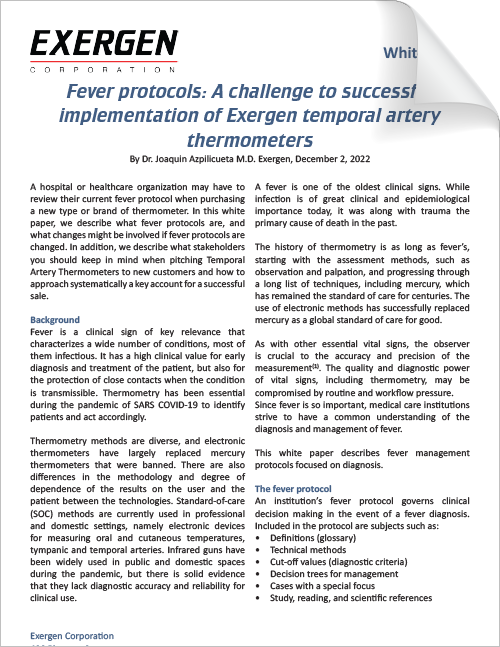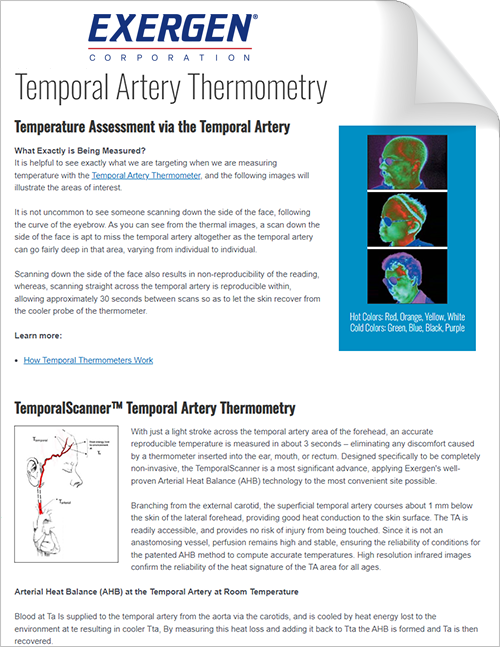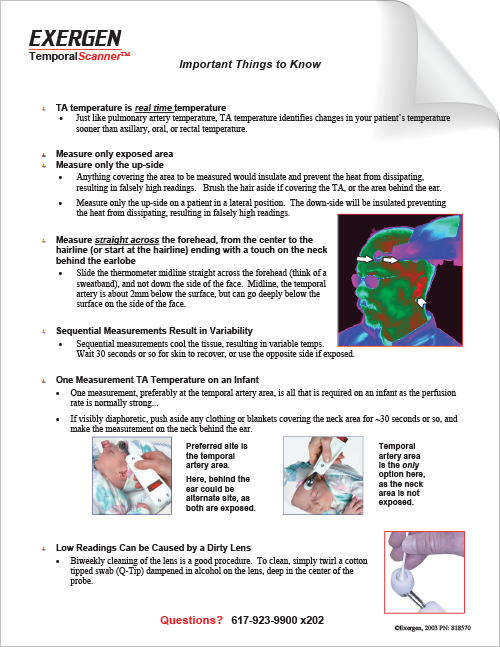

Temporal artery (TA) thermometry was originally developed in response to pediatricians requesting a replacement for ear thermometry due to inaccuracy, and rectal thermometry due to parents’ and clinicians’ growing disdain for rectal thermometers. The technology development spans some 20 years, borrowing heavily from methods originally invented for industrial processes and medical research in thermoregulation. Although the forehead has been used since antiquity to detect fever, accuracy had always been questionable due to poorly understood physiological artifacts. It wasn’t until these artifacts were identified, quantified and mathematically modeled has it been possible to measure clinically accurate body temperatures entirely non-invasively from the skin, with just a gentle scan of the forehead.
After 10 years and 35 published studies, it is now settled science that TA thermometry is more accurate than ear thermometers, and comparable in accuracy to rectal and oral thermometers. The physics are relatively straightforward, but the physiological requirements are not. Physiological artifacts can cause errors of more than 40F in conventional non-invasive thermometry at the skin and needed to be reduced by an order of magnitude to provide medically useful temperatures. The technology in more than 10 US patents is employed to overcome the errors.
Two unexpected major benefits for TA thermometry resulted from the technological development: a cost reduction of 90 percent compared to the standard thermometry methods, and the reintroduction into clinical medicine of what everyone appreciates from a caregiver when they are in need of care – a gentle reassuring touch to the forehead.
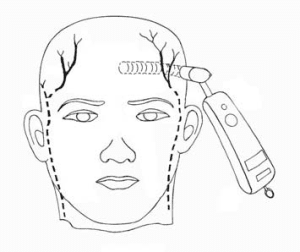

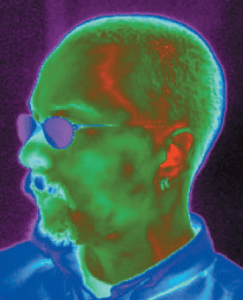

What is the central idea of temporal artery thermometry?
Measuring the temperature inside, from the outside – with medically accurate results equivalent to invasive methods. Conventional thermometry technology requires invasiveness more or less proportional to the accuracy desired. Starting with the most invasive/ most accurate and ending with the least invasive/least accurate, conventional thermometry can be ordered as (a) pulmonary artery catheter, (b) esophageal catheter, (c) rectal thermometer, (d) oral thermometer, (e) ear thermometer, (f) axilla thermometer, (g) skin thermometer. The central idea of TA thermometry is to have the non-invasiveness of a skin thermometer, but with the accuracy of an invasive thermometer such as a catheter or rectal thermometer.
What physics are employed to do this?
It starts with skin temperature. Naturally emitted infrared radiation can provide a thermal signal to measure temperature in a fast accurate manner. Radiation detectors are available that can detect this, but there is the problem of emissivity to contend with, which is the characteristic of skin to emit different amounts of radiation at a given temperature. Borrowing a technique originally developed for industrial use, TA thermometry employs an emissivity-correcting reflective cup within the scanning head. This corrects the emissivity automatically and eliminates all emission errors due to skin surface properties. For this to work, the scanning head of the TA thermometer must be close to, or preferably lightly touching, the skin.
Isn’t skin temperature inaccurate?
Yes, that is the reason there needed to be much more physiological insight for TA thermometry to work. In a normal environment, skin temperature will always be significantly lower than body temperature. This happens because metabolic heat is generated inside the body and has to flow outside the body to the cooler ambient temperature, which it does so at the skin. If we knew the physiology of how heat is flowing from inside the core to the outside through the skin, and we knew the ambient temperature, we could determine the inside temperature. This determination is automatically performed by the arterial heat balance system (AHB) algorithm programmed into the TA thermometer.
Can you measure anywhere on the skin instead of just at the temporal artery?
No. Further physiology is required. The skin temperature is heavily influenced by the local blood perfusion, which can vary hugely due to thermoregulation. The AHB algorithms require high and relatively stable skin perfusion to produce medically accurate body temperature. Research led to the superficial temporal artery (STA), which was found to lack arteriovenous anastomoses, an unusual property for a skin artery, effectively lacking valves which vary the skin perfusion. This meant that perfusion at the STA was essentially constant, and thus the AHB algorithms could produce medically accurate results. That an accessible part of the STA was located on both sides of the forehead above each eyebrow was especially convenient. There are some specific circumstances that produce high and stable skin perfusion that allow measurements in other locations, and users are instructed to use them when appropriate.
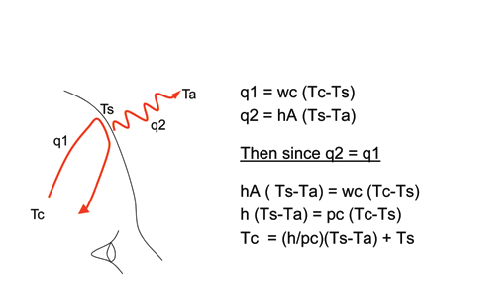

The superficial temporal artery is usually not visible. How do you find and measure it?
The STA is in a somewhat different location on each individual, which is the reason that TA thermometry employs a distinctive ‘scan’ of the forehead. The infrared detection system performs about 1000 measurements per second during the scan in a line across the forehead. Since the STA always traverses the forehead in a generally vertical direction, the scan across the forehead will always intersect the STA and detect the temperature of the skin over the STA. Of the several thousand readings in a scan, the AHB algorithm selects the peak reading, which is the most accurate, discarding the rest. Since STA at the forehead is always located between the skull and the skin, it is always very close to the skin surface, and a reliable temperature measurement can be made from newborns to seniors, allowing a single device to be medically accurate for all patients.
How is cost reduced by 90 percent?
This was one of the serendipitous benefits. Other medical thermometry systems require a probe to be inserted into a body cavity, which requires robust protection from contamination with a single-use disposable cover. TA thermometry lightly scans the intact skin of the forehead, placing it in the same category as a stethoscope – simply clean between patients. The reduced use of disposable probe covers turns out to be a major benefit from TA thermometry, eliminating approximately 90 percent of the direct cost of providing this vital sign. This savings figure does not include labor time savings – reported at 87 percent of nursing time by a recent independent study – or the cost of disposal of several tons of waste per year.
Further, since there is no small probe to be inserted into a body cavity, the TA thermometer can be designed to be far more robust than conventional thermometers, and can carry a lifetime warranty. This not only eliminates direct repair costs, but also greatly reduces all of the indirect costs, such as removal of equipment from service, evaluation by biomedical engineering, return to the manufacturer, receipt of the repaired device and reinstallation to service.
Since typical payback for TA thermometry is measured in months, hospitals using TA thermometry have essentially eliminated the cost of patient temperature as a vital sign.
How about the effect on caregiver-patient interaction?
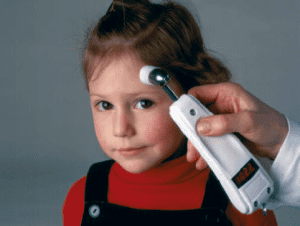

TA thermometer scanning a patient[/caption]The superficial temporal artery is usually not visible. How do you f ind and measure it? The STA is in a somewhat different location on each individual, which is the reason that TA thermometry employs a distinctive ‘scan’ of the forehead. The infrared detection system performs about 1000 measurements per second during the scan in a line across the forehead. Since the STA always traverses the forehead in a generally vertical direction, The idea of arterial heat balance (AHB) This serendipitous benefit was captured perfectly in a recent episode of the popular TV program Grey’s Anatomy, depicting a physician gently scanning the patient with his personal TA thermometer, while checking the patient’s chart and joking amiably about his discharge (see www.exergen.com for the clip). This interaction captures something unexpected and quite important – that the gentle touch of scanning the patient’s forehead with a TA thermometer evokes an emotional response of care given, and care accepted, from the caregiver and patient – the same as a mother’s touch to the forehead of a sick child. This very much enhances the patient-caregiver experience, and is a significant reason why patients and caregivers are such strong supporters of TA thermometry.
TA thermometry every year eliminates nearly a billion probe insertions into patients’ body cavities, replacing each one with a gentle touch of the forehead. This converts a billion unpleasant experiences for patients and caregivers to a billion very positive experiences for both – a major contribution to everyone’s sense of wellbeing. Hopefully, soon the other five billion or so thermometry probe insertions per year will be converted as well.
Francesco Pompei is Founder and CEO of Exergen Corporation, and holds 60 US patents in non-invasive thermometry for medical and industrial applications. Earning BS and MS degrees from MIT, and SM and PhD from Harvard, Pompei also holds an appointment as Research Scholar in the Dept. of Physics at Harvard in cancer research.


